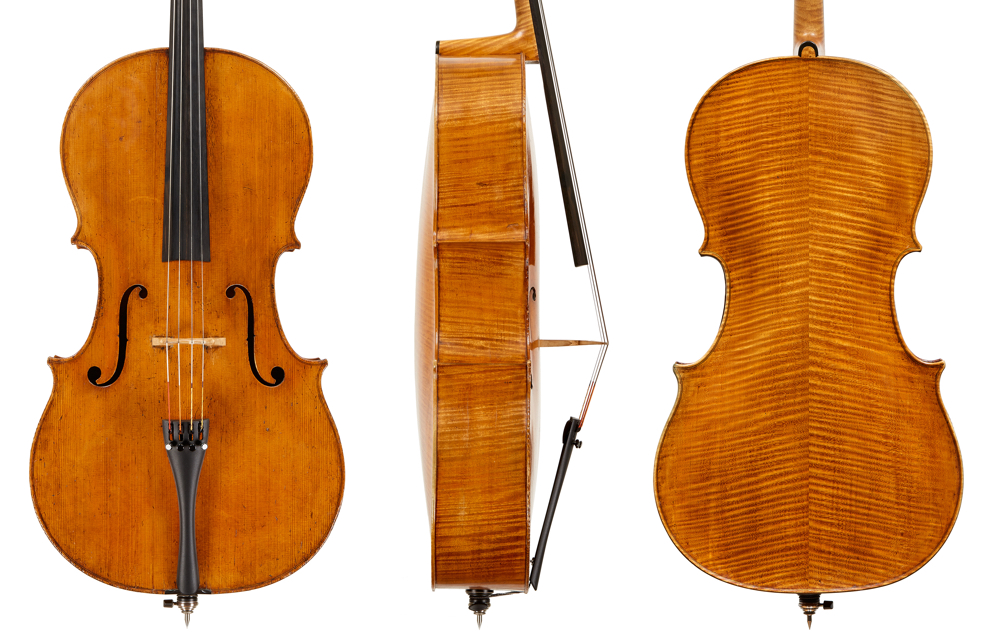Among the great 18th-century Venetian instrument makers, Santo Serafin (1699–1776) was the most refined craftsman. Serafin consistently produced distinctive instruments with first-class wood and superb varnish that are highly sought after today.
Serafin emigrated to Venice from his native Udine in 1721. Although it remains unconfirmed, Serafin may have received his initial training from Francesco Goffriller, with whose work he shares stylistic similarities. Prior to joining the Arte dei Marzeri (the Venetian Instrument Makers’ Guild) as a merchant in 1733, Serafin might have worked for other established shops in Venice, but little documentary evidence of his early time in Venice has so far come to light. The Marzeri journals record a high sales volume for Serafin from the opening of his business in 1733 through the 1730s – greater than that of his contemporaries Pietro Guarneri or Domenico Montagnana, for instance.
The lavish materials and high level of finish consistently found in Serafin’s work reinforce the impression of a highly successful maker serving a discerning clientele. Success notwithstanding, the burden of the taxes imposed by the Marzeri Guild was probably a major factor in Serafin’s decision to close his business and resign from the guild in 1744. [1] Subsequently he remained in the guild as an artisan, which allowed him to work in the city under a more modest tax burden until his death in 1776.
Serafin’s cello models are all of smaller dimensions than those found in earlier Venetian cellos, reflecting the evolving role of the cello in the music of the early to middle 18th century. The smaller size would have facilitated the agility required by the increasingly florid and high cello parts written during this period. The range of sizes found in Venetian cellos from well into the middle of the 18th century bears witness to a time of experimentation when bass instruments likely served different roles in a range of ensemble situations (see figure 1).
Figure 1: Venetian cellos 1723–1750 (dimensions in mm)
| Cello | Cozio ID | LOB | UB | MB | LB |
|---|---|---|---|---|---|
| Montagnana, 1742 | 42639 | 745 | 375 | 253 | 458 |
| Busan, c. 1750 | 78016 | 679 | 313 | 228 | 393 |
| Goffriller 1723, ‘Lutyens’ | 42875 | 760 | 352 | 236 | 459 |
| Deconet 1764 | 44531 | 714 | 338 | – | 418 |
| Serafin 1740 | 22625 | 715 | 331 | 234 | 411 |
| Serafin 1732, ‘Reiffenberg, Hoelscher’ | 44081 | 730 | 351 | 236 | 429 |
By the end of the 18th century the Republic of Venice had broken up and economic conditions no longer favored high-end instrument making. The string section as it would survive had taken shape throughout Europe and smaller form cellos had won favor. Small cellos are all that can be found among the limited output of the remaining Venetian makers and of other Italian artisans including G.B. Guadagnini from the mid 18th century onwards:
Figure 2: Guadagnini cellos 1752–1783 (dimensions in mm)
| Cello | Cozio ID | LOB | UB | MB | LB |
|---|---|---|---|---|---|
| Guadagnini, 1752 | 64418 | 714 | 332 | 232 | 420 |
| Guadagnini, 1754, ‘Gerardy’ | 40959 | 714 | 334 | 233 | 419 |
| Guadagnini, 1762, ‘Chi Mei’ | 71104 | 710 | 330 | 240 | 418 |
| Guadagnini, 1777, ‘Simpson’ | 40870 | 715 | 334 | 246 | 421 |
| Guadagnini, 1783, ‘Huxham’ | 24696 | 710 | 333 | 244 | 422 |
Figure 3: Venetian cellos c. 1795–c. 1800 (dimensions in mm)
| Cello | Cozio ID | LOB | UB | MB | LB |
|---|---|---|---|---|---|
| Bellosio c. 1795 | 47399 | 718 | 350 | 241 | 435 |
| Cerin c. 1800 | 49442 | 725 | 340 | 233 | 423 |
It is worth noting that the majority of 17th and early 18th century Italian cellos in use today have been reduced in size to conform to usage in the traditional symphonic and chamber music canons.
The instrument
The cello illustrated is typical of Serafin at his best. Extravagant materials and meticulous details of finish are brought together by the confident hand of a mature master. Brilliantly flamed maple formed into a two-piece back is matched in the sides and the head. Narrow, even-grained spruce in the two-piece top shows a trace of ‘hazel fichte’ figure observable in tone wood of the highest quality. With short corners and open C-bouts, the narrow model gives the player ample access in high positions, while the low, graceful arching simultaneously provides power and color. The f-holes are based on a Brothers Amati template, but with shorter wings that angle gently.

